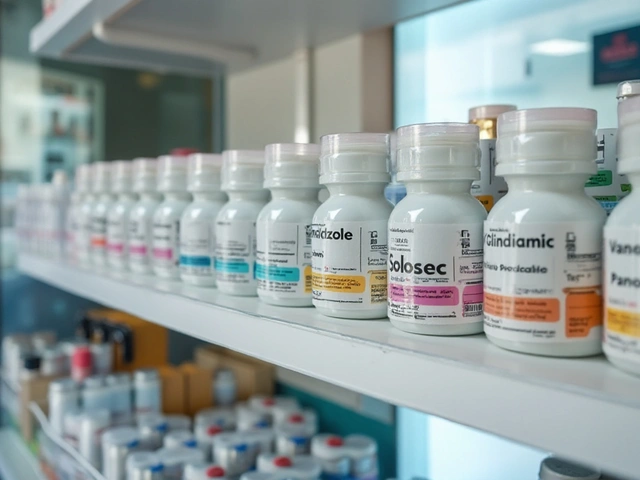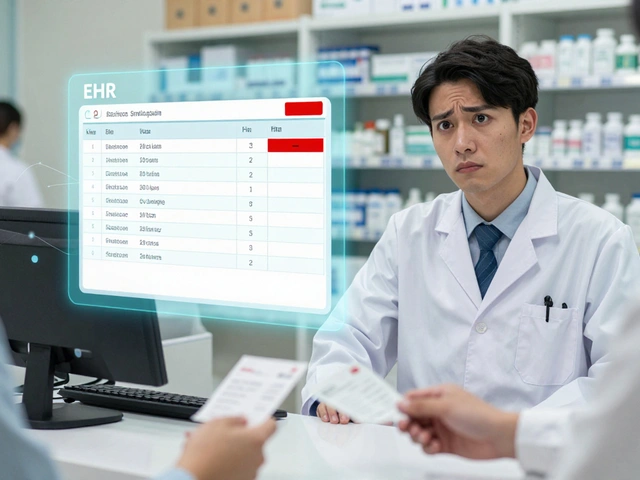Medication Dry Eye Risk Checker
Is Your Medication Causing Dry Eyes?
Check if your medications may be contributing to dry eyes. Based on the latest research, up to 25% of dry eye cases are medication-related.
Your Risk Level:
Personalized Recommendations
Why Your Medications Are Making Your Eyes Feel Like Sandpaper
You’re taking your pills just like your doctor told you-blood pressure meds, antidepressants, even that allergy pill you grab off the shelf. But lately, your eyes burn. They feel gritty. You blink and your vision blurs for a few seconds. You’ve tried eye drops, but they only help for a few minutes. If this sounds familiar, you’re not alone. About one in four people with dry eyes have them because of their medications, not because they’re staring at screens too long or sitting in a dry office. For people over 65, that number jumps to nearly 40%. It’s not in your head. It’s not just aging. It’s your meds.
Medications don’t just target your symptoms-they affect your whole body. And your eyes? They’re one of the first places it shows. Some drugs shut down the nerves that tell your tear glands to make tears. Others mess with the oily layer that keeps your tears from evaporating. Some even dry you out from the inside, pulling fluid out of your body like a sponge. The result? Your eyes don’t have enough moisture to stay comfortable.
Which Medications Are the Worst Offenders?
Not all drugs cause dry eyes the same way. Here are the big ones you need to watch for:
- Antihistamines like Benadryl, Claritin, and Zyrtec-they’re great for sneezing, but they also block the signals your tear glands need to produce moisture.
- Antidepressants including Zoloft, Prozac, amitriptyline, and nortriptyline. These affect brain chemicals, but they also slow down tear production.
- Blood pressure meds like metoprolol, atenolol, and diuretics such as hydrochlorothiazide and Lasix. Diuretics make you pee more-and that means less fluid for your eyes.
- Glaucoma eye drops with benzalkonium chloride (BAK) preservative. These are the #1 cause of dry eye in people using eye drops daily. Up to 47% of users get irritation from the preservative alone.
- Isotretinoin (Accutane) for acne. This drug shrinks oil glands all over your body-including the ones on your eyelids that keep your tears from drying out.
- Chemotherapy drugs like methotrexate and cisplatin. These can damage tear glands directly.
- Newer drugs like immune checkpoint inhibitors and diabetes meds (gliptins) are now showing up in studies as dry eye triggers too.
Here’s the thing: You might not realize your medication is the problem. Dry eyes feel like a nuisance, not a side effect. But if your symptoms started or got worse after you began a new drug, that’s a red flag.
Lubrication That Actually Works
Just grabbing any eye drop off the shelf won’t cut it. Most over-the-counter drops have preservatives-chemicals that kill bacteria but also irritate your eyes over time. If you’re using them more than 4 times a day, you’re adding fuel to the fire.
Switch to preservative-free artificial tears. These come in single-use vials or special bottles designed to stay sterile without chemicals. Use them 4 to 6 times a day, even if your eyes feel fine. Prevention beats relief every time.
If you use glaucoma drops, time your artificial tears right. Wait 15 minutes after your prescription drops before using lubricants. That way, your eye gets the full dose of the medicine without the tear drops washing it away. Studies show this simple timing trick improves symptoms by 78%.
For stubborn cases, your eye doctor might prescribe:
- Restasis (cyclosporine)-takes 3 to 6 months to work, but boosts natural tear production by 15-20%.
- Xiidra (lifitegrast)-reduces dryness and irritation in about 30% of users within weeks.
- Cequa-a newer, more powerful version of cyclosporine that works better because it’s formulated with nanomicelles to get deeper into the eye.
For people with blocked oil glands (common with Accutane or aging), warm compresses and lid massages help. Do this twice a day: heat a clean washcloth in the microwave for 20 seconds, lay it over closed eyes for 10-15 minutes, then gently massage your eyelids with your finger. This melts the thick oil in your glands so your tears stay smooth and stable. About 65% of people see improvement with this routine.

Lifestyle Changes That Make a Real Difference
Eye drops alone won’t fix everything. Your environment and habits matter just as much.
Use a humidifier. Dry air pulls moisture from your eyes. Keeping indoor humidity between 40% and 60% cuts tear evaporation by 25%. A simple tabletop humidifier by your bed or desk helps more than you think.
Follow the 20-20-20 rule. Every 20 minutes, look at something 20 feet away for 20 seconds. This isn’t just for screen time-it’s for reading, sewing, driving, or any task where your eyes focus close up. Your blink rate drops when you concentrate, and that leads to faster drying. This rule reduces digital eye strain by 35% in people on antihistamines or antidepressants.
Get more omega-3s. Fish oil supplements with 1,000-2,000 mg of EPA and DHA daily improve tear film quality in 60% of users within 3 months. Flaxseed oil doesn’t cut it-stick with fish-derived omega-3s. They help rebuild the oily layer of your tears.
Avoid direct airflow. Car vents, ceiling fans, and AC units blowing straight at your face? They’re drying you out. Keep airflow below 0.15 m/s near your face. Adjust your seat, use a shield, or turn off the fan.
Quit smoking. Smoke doesn’t just hurt your lungs-it makes dry eyes 45% worse. Even secondhand smoke triggers inflammation. People who quit see noticeable relief in 2 to 4 weeks.
Don’t Stop Your Meds-Talk to Your Doctor
Some people think the answer is to stop their medication. Don’t do it without talking to your doctor. Stopping blood pressure pills or antidepressants cold turkey can be dangerous.
Instead, ask your doctor: “Is there another medication that’s less likely to cause dry eyes?” For example:
- Switch from a BAK-containing glaucoma drop to a preservative-free version. Symptoms drop from 47% to 16%.
- Change from an antihistamine like Benadryl to a non-sedating one like loratadine, which has less impact on tear production.
- Adjust your antidepressant-some SSRIs like escitalopram cause fewer dry eye symptoms than others.
Even small dose reductions help. One study found 55% of patients improved just by lowering their medication amount-without losing the benefit.
Work with both your prescribing doctor and your eye doctor. They need to talk to each other. A coordinated plan is the only way to treat the root cause, not just the symptoms.

When Simple Fixes Aren’t Enough
Some cases are stubborn. If you’ve tried everything and your eyes still burn, there are more advanced options:
- Punctal plugs-tiny devices inserted into your tear ducts to keep tears from draining too fast. Temporary collagen plugs last 3-6 months and work for 70% of users. Silicone plugs are permanent and boost tear volume by 40-50%.
- iLux or LipiFlow-in-office thermal treatments that melt blocked oil glands. One user on Reddit said it cost $500 per session but gave her 80% relief after Accutane wrecked her glands.
- Autologous serum drops-made from your own blood, these are like premium tears. Used for severe cases where nothing else works.
These aren’t cheap, and insurance doesn’t always cover them. But for people who’ve tried everything else, they can be life-changing.
What to Expect and How to Stay on Track
Improvement doesn’t happen overnight. With preservative-free drops and warm compresses, you might feel better in 2-4 weeks. But if you’re using Restasis or Cequa, give it 3 to 6 months. Don’t quit early.
Proper technique matters. Don’t let the dropper touch your eye. Tilt your head back, pull down your lower lid, and let the drop fall in. If you squeeze too hard, you waste half the bottle.
Consistency is everything. Sixty percent of success comes from sticking to the routine-not just the medicine. Skip a day of compresses? Your glands get sluggish again. Forget your drops for a few days? Your eyes feel worse than before.
And don’t ignore the cost. Restasis runs about $550 a month in the U.S. Many people can’t afford it. Ask about generics, patient assistance programs, or mail-order pharmacies. Some insurers cover preservative-free drops if you submit a letter from your doctor explaining the medical need.
The Bigger Picture
Dry eye from medications is no longer a footnote. It’s the third most common reason people visit an eye doctor in the U.S.-after cataracts and diabetic eye disease. The global market for dry eye treatments is growing fast, hitting nearly $8 billion by 2030. That’s because more doctors are finally paying attention.
New research is underway. The NIH is testing a special lipid emulsion for people on Accutane. The FDA just approved a new preservative-free cyclosporine with better absorption. More eye doctors are using advanced tests like tear osmolarity and gland imaging to personalize treatment.
The message is clear: Dry eyes from meds are real, common, and manageable. You don’t have to live with gritty, burning eyes. You just need to know what’s causing it-and how to fix it, step by step.











Michelle N Allen
29 Nov 2025 at 00:37I've been on lisinopril for years and my eyes have felt like I rubbed sand in them since day one. Never connected it to the med until now. I just thought I was getting old. Guess I'll ask my doc about switching. I'm too lazy to look up alternatives myself though.